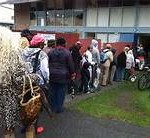 Mary Hendrickson is Assistant Professor of Rural Sociology at the University of Missouri. Her research focuses on local food systems and consolidation in the industrial food system. She will speak at the UVM Food Systems Summit on June 27. In anticipation, we spoke with her about why these issues are important for farmers and eaters alike.
Mary Hendrickson is Assistant Professor of Rural Sociology at the University of Missouri. Her research focuses on local food systems and consolidation in the industrial food system. She will speak at the UVM Food Systems Summit on June 27. In anticipation, we spoke with her about why these issues are important for farmers and eaters alike.
University of Vermont: Your research has investigated the role of corporate consolidation in the agri-food industry. Why is this issue important?
Mary Hendrickson: My work has always focused on the structure of relationships in the food system, and how local food systems can be a response to the power issues that emerge in the more globalized and consolidated industrial food system. It can feel very disempowering to only look at the issues of industry concentration. So it’s important to look at what the solutions might be. Continue reading


















